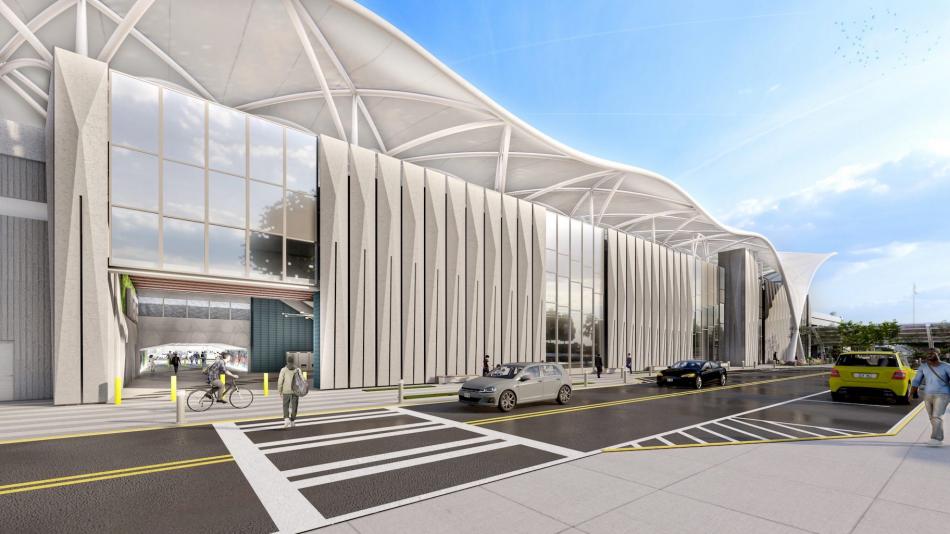Early concepts have emerged that depict one of MARTA’s most popular—but oldest and coldest—stations as a modernized transit hub that’s generally more inviting to passengers.
Atlanta-based Chasm Architecture has been hired as the prime design consultant tasked with reimagining H.E. Holmes station, MARTA’s westernmost train stop and one of the system’s busiest and largest stations.
Renderings published by Chasm show the 42,300-square-foot structure remade from “a staid public rail station” into “a unique form expressive of movement,” as the design team puts it.
MARTA announced plans in January to gather public input and begin the process of redeveloping the 22-acre H.E. Holmes station property, located near Interstate 285, into “a diverse mix of land uses” with “new neighborhood centers.” The property today includes dated facilities and more than 1,400 free parking spaces.
 An architectural rendering drawn up in 2023 by Chasm Architecture illustrates how H.E. Holmes station's south elevation could look and function. Chasm Architecture
An architectural rendering drawn up in 2023 by Chasm Architecture illustrates how H.E. Holmes station's south elevation could look and function. Chasm Architecture
Chasm Architecture’s focus is on the station itself, and the firm is designing both exteriors and interiors. The concrete H.E. Holmes structure remains “solidly built” but is “cold and uninviting to the 22,000 patrons who use it daily,” architects note in a project description.
Plans call for removing much of the concrete to create more transparent structures, including a chrysalis over train platforms and glass curtainwalls that would allow light to penetrate across the concourse, according to architects.
Designers also plan to work with MARTA’s public art outreach program, Artbound, to incorporate artworks throughout.
When asked about the renderings, a MARTA spokesperson sent a link to the H.E. Holmes station’s website for the latest information on the project.
Opened in 1979, H.E. Holmes station, also known as Hamilton E. Homes, is the last western stop on MARTA’s Blue Line, offering both local and regional bus connections, too.
MARTA has specified that all 22 acres around H.E. Holmes station likely won’t be developed at the same time, as a phased approach would allow for construction to coincide with current transit operations, including parking for MARTA riders. It’s one of five stations MARTA pinpointed last year—from Bankhead to Brookhaven and Stone Mountain—as being ripe for redevelopment to create more active uses.
The H.E. Holmes project’s budget has yet to be determined, according to the architecture team.
Earlier this year, MARTA launched the interactive website, distributed an online survey, and hosted several community sessions to gather feedback on the H.E. Holmes TOD master plan. That process concluded in March.
High on the H.E. Holmes wish list for meeting attendees was “higher quality retail” such as a grocery store, improved infrastructure (sidewalks, street lighting, and roads), higher-density housing, a communal greenspace, and sports offerings for youth, according to MARTA.
MARTA officials have said the next step is to finalize a master plan and take that through the City of Atlanta’s rezoning process. The agency would then solicit proposals from potential developers, similar to the process for MARTA’s Bankhead station last year that culminated in the selection of a development team in October.
H.E. Holmes station is named for Dr. Hamilton Earl Holmes, an Atlantan celebrated for desegregating the University of Georgia, alongside Charlayne Hunter-Gault. Redevelopment of the agency’s westernmost station would join other MARTA-led TOD projects from Grant Park to Edgewood and Decatur’s eastern fringes that have transformed parking lots into multifamily housing and other uses.
...
Follow us on social media:
• MARTA-related news, discussion (Urbanize Atlanta)










